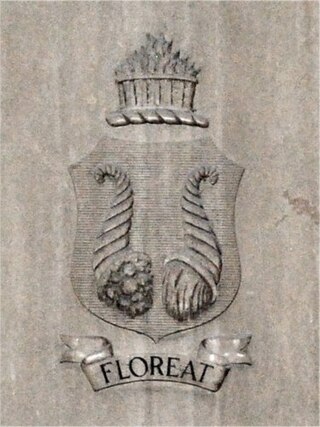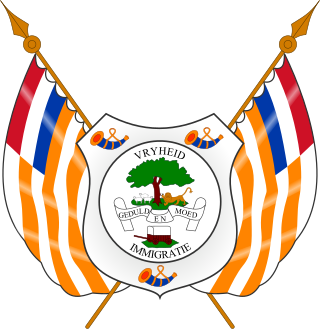 | |
| Use | Civil and state flag, state ensign |
|---|---|
| Proportion | 1:2 |
| Adopted | 1876 |
The flag of Cape Colony was the official flag of the Cape Colony from 1876 to 1910. It formed part of a system of colonial flags that was used throughout the British Empire.
 | |
| Use | Civil and state flag, state ensign |
|---|---|
| Proportion | 1:2 |
| Adopted | 1876 |
The flag of Cape Colony was the official flag of the Cape Colony from 1876 to 1910. It formed part of a system of colonial flags that was used throughout the British Empire.
In a series of decisions made in 1864, 1865, and 1869, the UK's government decided that every colony should have a distinctive badge, to be displayed on flags at sea. The governor was to display the badge in the center of the Union Jack when travelling by sea; vessels owned by the colony's government were to display it in the fly of the Blue Ensign; and, with Admiralty permission, privately owned ships registered in the colony could display the badge in the fly of the Red Ensign. This system is still in operation in the remaining British overseas territories. [1]
The Cape government was initially not in favor of the system but eventually complied with British government requests to adopt a flag badge. The Molteno ministry decided to introduce a coat of arms, which would also serve as the flag badge. [2] The coat of arms was first displayed on a flag at the laying of the foundation stone of the Houses of Parliament on 12 May 1875. [3] It was formally granted by Queen Victoria on 29 May 1876, and made its official appearance as a flag badge shortly afterwards. It was used until the colony was incorporated into the Union of South Africa on 31 May 1910.
The flag badge consisted of the Cape Colony coat of arms on a white disc. The coat of arms consisted of a red shield displaying a golden lion between three golden rings, below a silver horizontal strip ('chief') containing three golden fleurs de lis on blue discs. The figure of Hope formed the crest, and the shield was supported by a wildebeest and a gemsbok. The motto 'Spes Bona' ('Good Hope') was displayed below the shield.

The coat of arms of South Africa is the main heraldic insignia of South Africa. The present coat of arms was introduced on Freedom Day, 27 April 2000, and was designed by Iaan Bekker. It replaced the earlier national arms, which had been in use since 1910. The motto is written in the extinct ǀXam, member of the Khoisan languages, and translates literally to "diverse people unite". The previous motto, in Latin, was Ex Unitate Vires, translated as "From unity, strength".

The flag of South Africa was designed in March 1994 and adopted on 27 April 1994, during South Africa's 1994 general election, to replace the previous flag used from 1928–1994.

The Red Ensign or "Red Duster" is the civil ensign of the United Kingdom of Great Britain and Northern Ireland. It is one of the British ensigns, and it is used either plain or defaced with either a badge or a charge, mostly in the right half.

The current state flag of South Australia, was officially adopted in 1904.

The current state flag of New South Wales was officially adopted in 1876. The flag is based on the defaced British Blue Ensign with the state badge located in the fly. The badge, based on the coat of arms, is a white disc with the cross of St George, a golden lion passant guardant in the centre of the cross and an eight-pointed gold star on each arm of the cross.

The coat of arms of the Cape Colony was the official heraldic symbol of the Cape Colony as a British colony from 1875 to 1910, and as a province of South Africa from 1910 to 1994.

The coat of arms of Namibia is the official heraldic symbol of Namibia. Introduced at the time of independence in 1990, it superseded the earlier coat of arms used by the South African administration of the territory.

The flag of the Natalia Republic was the official flag of this short-lived South African state, which existed from 1839 to 1843.

The flag of the Orange Free State was officially used from 1857 to 1902. It was superseded by the flag of the Orange River Colony.

South African heraldry dates back to the 1650s, inheriting European heraldic traditions. Arms are borne by individuals, official bodies, local authorities, military units, and by a wide variety of organisations. South Africa has had its own heraldic authority since 1963, to provide armigers with legal protection, and to promote high standards of armorial practice.

The Flag of Transvaal was the official flag of the Transvaal colony in South Africa from circa 1903 to 1910. It formed part of a system of colonial flags that was used throughout the British Empire. It was superseded by the flag of the Union of South Africa.

Since unification in 1910, South Africa has used a range of national symbols to identify the country: coats of arms, official seals, flags, national anthems, and floral, bird, animal, and other emblems.

The coat of arms of the Orange Free State was the official heraldic symbol of the Orange Free State as a republic from 1857 to 1902, and later, from 1937 to 1994, as a province of South Africa. It is now obsolete.

The coat of arms of Natal was the official heraldic symbol of Natal as a British colony from 1907 to 1910, and as a province of South Africa from 1910 to 1994. It is now obsolete.

The coat of arms of the Transvaal was the official heraldic symbol of the South African Republic from 1866 to 1877 and again from 1881 to 1902, and later the symbol of the Transvaal Province from 1954 to 1994 in a simplified form. It is now obsolete.
The coat of arms of the Orange River Colony was the official heraldic symbol of the Orange River Colony as a British colony from 1904 to 1910, and then of the Orange Free State province of South Africa from 1910 to 1925. It is now obsolete.

The flag of Natal was the official flag of the South African colony of Natal from 1870 to 1910. It formed part of a system of colonial flags that were used throughout the British Empire.

The flag of the Orange River Colony was the official flag of the Orange River Colony in South Africa from 1904 to 1910. It formed part of a system of colonial flags that was used throughout the British Empire. It was superseded by the Flag of the Union of South Africa.

The South African Republic, which existed from 1852 to 1877, 1881 to 1902, and 1914 to 1915, used two flags: (1) the so-called 'Vierkleur' from 1857 to 1874, and again from 1875 to 1877 and 1881 to 1902, and (2) the so-called 'Burgers Flag' from 1874 to 1875. They were superseded by the flag of Transvaal. The Vierkleur was also used by the South African Republic declared in 1914 during the Maritz Rebellion, which lasted into February 1915.